AEROSPACE Aviation and the environment
Turning aviation green
BILL READ FRAeS reports on a technical conference held at the 2020 Singapore Air Show which considered the environmental challenges faced by aviation and ways that they can be solved through new designs, alternative power sources and methods of operation.
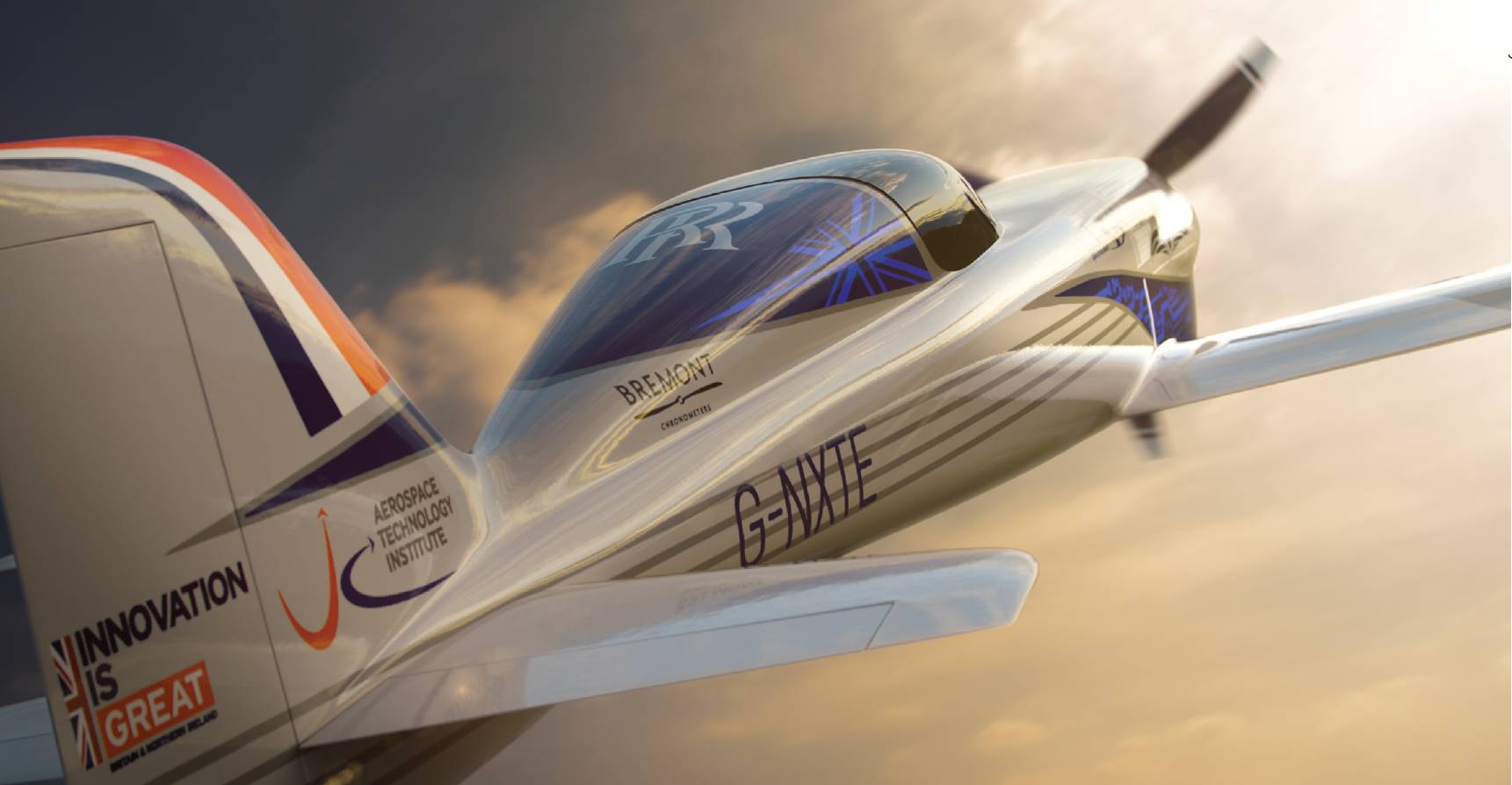 The ACCEL is an electric aircraft demonstrator developed by Rolls-Royce. Rolls-Royce
The ACCEL is an electric aircraft demonstrator developed by Rolls-Royce. Rolls-Royce
On 10 February, during the 2020 Singapore Air Show, the Singapore aerospace association A*STAR, hosted the Singapore Aerospace Technology Leadership Forum (SATLF). The conference looked at two areas of emerging technology – the increased use of artificial intelligence (AI) and digitalisation in airline operations and the aerospace industry and also how new technology and aircraft designs could tackle the issue of climate change. Part 2 of this two-part report looks at how the aerospace industry is responding to the green aviation challenge. “The world is turning green,” commented Mike Stewart, VP, Advanced Technology, Honeywell Aerospace. Recent years have seen an increased focus on environmental issues, in particular the effect that rising levels of CO2 2 in the Earth’s atmosphere has on global warming.
Francis Preli, Pratt & Whitney, VP Propulsion and Materials Technology, explained how the environment is just one of the challenges currently facing aviation, alongside the demand for mobility, oil prices and availability, maintaining customer value and making profits. These targets are not all compatible as, the faster the growth in demand for air travel, the greater the percentage of greenhouse gases created by aviation.
Aviation affects the Earth’s atmosphere in different ways at different altitudes. At the highest level in the stratosphere, NOX X and halogens affect the ozone layer, in the troposphere CO2 2, NOX X, H2 2 O and particulates affect climate change while, at ground level, NOX X, CO2 2 and particulates affect local air quality, as well as noise pollution from aircraft arriving or departing from airports and at ground level.
To tackle the problem of global warming, the International Civil Aviation Organization (ICAO) has created CORSIA (Carbon Offsetting and Reduction Scheme for International Aviation) with the aim of halving 2005 levels of CO2 2 emissions by 2050. There are also other schemes, including the Air Transport Action Group (ATAG) waypoint project which also has the goal of halving CO2 2 emissions by 2050, while the European Commission Green Deal requires Europe to be climate neutral by 2050.
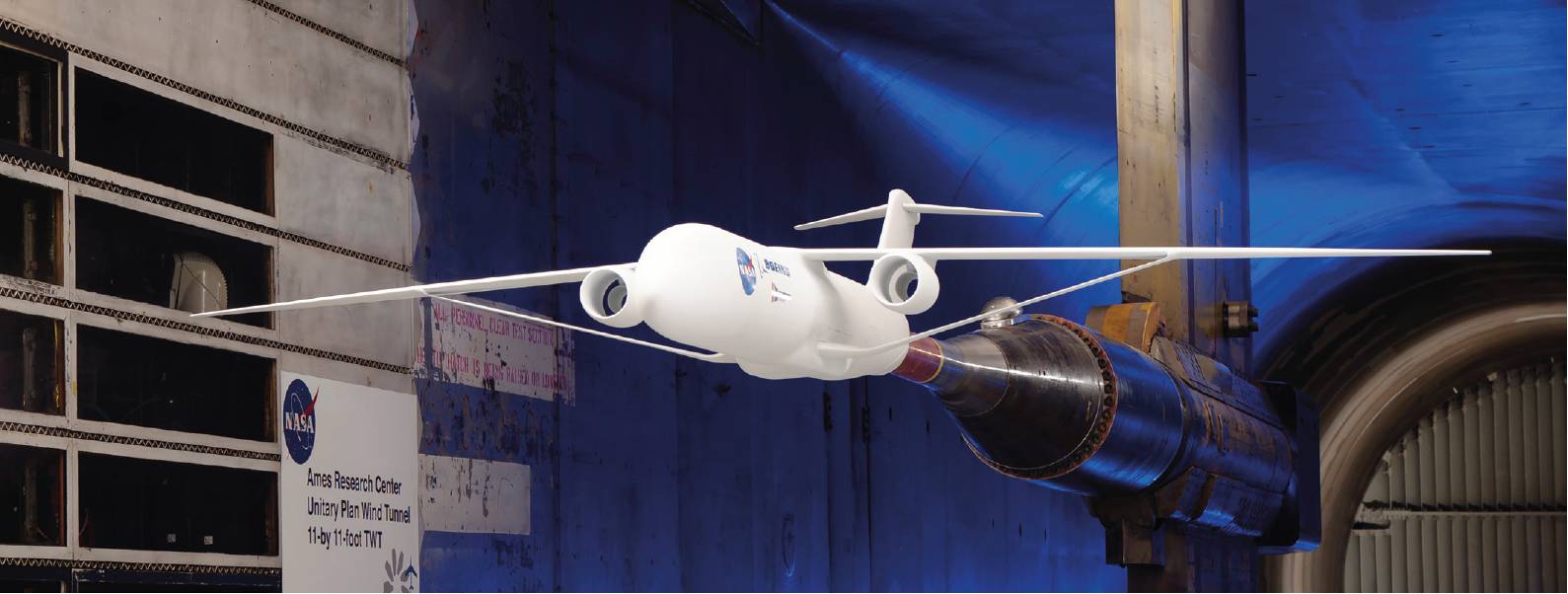 In the US, attention has focused on truss braced wings as the next configuration for green airliners. NASA
In the US, attention has focused on truss braced wings as the next configuration for green airliners. NASA
Redesigning aircraft
Francis Preli considered that there are three ways that commercial aviation could develop more environmentally friendly aircraft of the future – through the evolution of existing designs, by innovation to improve existing designs or by disruption through the introduction of completely new designs. “Disruptive aircraft designs could reduce fuel consumption by 30-40%,” said Benoit Guyon, VP R&T Partnership, Safran.
The aerospace industry is already working on technical solutions to the problem. Last year, a consortium of chief technical officers from a number of leading aerospace companies published a joint declaration at the 2019 Paris Air Show to work together on improving fuel efficiency. Airbus has already been involved in a number of new aircraft technology projects, including the BLADE laminar flow on wings project, dynamic hinged wings Albatross 1 project and boundary layer research with ONERA.
The electric revolution
Recent years have seen a revolution in aircraft propulsion systems, with hybrid-electric and battery-powered electric aircraft now becoming an economically viable alternative to conventional platforms – at least for smaller, short-range aircraft. Such aircraft are the ideal solution to the problem of reducing CO2 2, as they produce no (or in the case of hybrid-electric propulsion – fewer) direct carbon emissions (although the generation of the electricity to charge the batteries may do so).
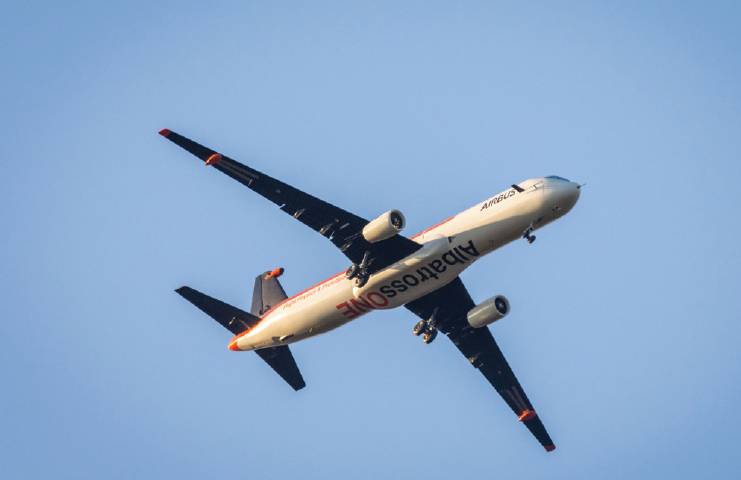 The Airbus AlbatrossOne, revealed in July 2019, is a scale demonstrator exploring freely flapping wing tips to reduce weight and drag. Airbus
The Airbus AlbatrossOne, revealed in July 2019, is a scale demonstrator exploring freely flapping wing tips to reduce weight and drag. Airbus
Beginning with powered gliders, the potential of electric aircraft has expanded to include light aircraft and small electric vertical take-off and landing (eVTOL) personal air vehicles and air taxis and the concept is now being actively considered for larger regional aircraft powered by electric motors or multiple distributed power systems. Airbus has been involved in a series of aircraft electrification projects and is moving towards the goal of developing a hybrid propulsion single-aisle aircraft in the 2020s.
However, there are still significant barriers to be overcome before electric propulsion can be used as a viable alternative to conventional fossil fuel engines – the biggest of which is the power and duration of the batteries. “Pure electric storage is not a very efficient way of storing energy,” said Paul Stein from Rolls-Royce. “On the ground or in ships, where weight or size isn’t an issue, this isn’t a problem but it is when it comes to aircraft where there is a battle against gravity. The case for powering very short-range aircraft is good for pure batteries but not so good for longer-range. There are also safety issues to be resolved with recharging batteries, as was demonstrated in the early days of the Boeing 787.”
In the meantime, speakers agreed that interim progress could be made using hybrid-electric battery-assisted engines.
Big and small aircraft
When considering new ‘greener’ aircraft designs, the conference speakers explained how two different approaches needed to be taken for large and smaller aircraft. Mike Stewart predicted that future environmentally sustainable aircraft designs are likely to be divided into two main categories depending on their size and range: (1) regional – short-range powered by hybrid and distributed propulsion; and (2) long and medium-range powered with ultra-efficient gas turbines and novel engine concepts.
Although there has been progress towards the development of new smaller electric-powered aircraft, their introduction would not have a huge effect on reducing carbon emissions, as they are not the largest sector of the market. Francis Preli described how the amount of CO2 2 produced by aircraft depends on the size, range and number flying. Airliners above 30t GTOW (gross takeoff weight) produce 98% of the CO2 2, with twin aisles accounting for 57% of emissions, single aisles 36%, regional jets 5%, business jets 1% and turboprops 1%. Paul Stein added that 65% of all aviation fuel consumption is used on flights beyond 1,000 miles. Improvements to large aircraft designs will therefore have a bigger overall effect on reducing CO2 2 emissions than changes to smaller aircraft.
Engine design
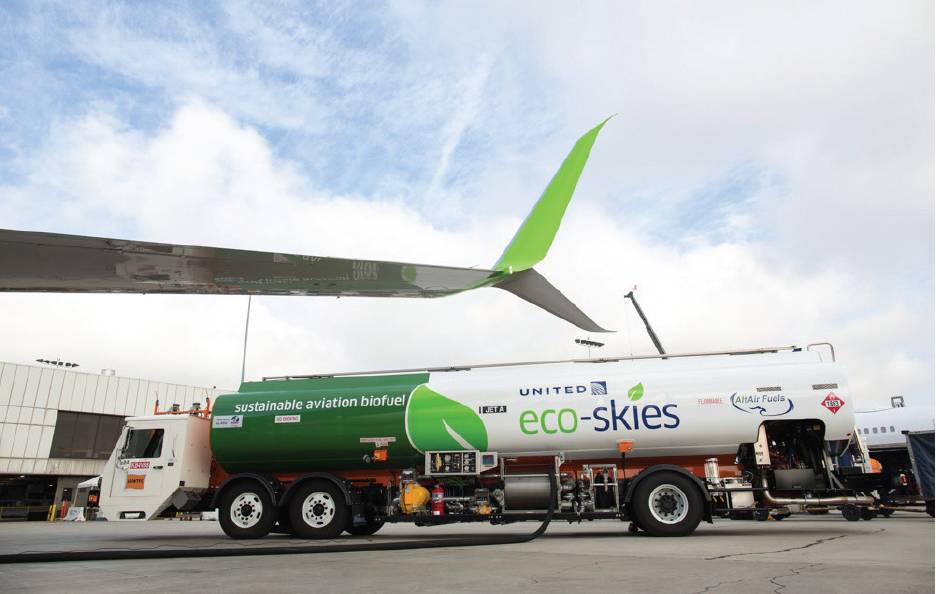 Biofuels could begin to replace fossil fuels over the next 30 years. United Airlines
Biofuels could begin to replace fossil fuels over the next 30 years. United Airlines
As electric propulsion is not currently a viable alternative for larger long-range aircraft, attention has been focused on ways to make liquid fuel-powered engines more efficient.
Francis Preli described how, when it comes to using alternative power sources, it is more difficult to store energy on bigger aircraft, compared to liquid fuels. “Beyond 1,000nm we’re going to have to improve efficiency on fuels,” said Paul Stein.
Recent years have seen the development of more efficient jet engines with reduced fuel burn using bigger fans, high bypass turbofans, geared engines and ultra-high bypass geared turbofans. Paul Stein was of the opinion that long-range middle-of-market and widebody aircraft could best be powered by ultra-high bypass ration (UHBR) jet turbine engines fitted with embedded generators, electric distribution systems, limited energy storage and boundary layer ingestion (BLI) fans.
Sustainable fuels
The other area of interest for the future development of greener large aircraft has been in the creation of sustainable fuels. Although new reserves of oil are still being discovered, fossil fuel stocks will not last forever and the aerospace industry is working on the development of sustainable alternatives. Paul Stein explained how aviation is going to have to use more biofuels and sustainable aviation fuels (SAFs). “We’re going to need 500m tonnes of SAFs by 2050 to create net-zero carbon,” he said.
There are two main types of sustainable fuels. One is ‘drop-in’ SAFs made from waste and biomass while the other is synthetic ‘electrofuels (e-fuels)’ created by using electricity created by renewable energy to take hydrogen from water which can be synthesised with carbon from CO2 2 to produce liquid fuels which can be used in a conventional engine. However, there are problems still to be overcome with the creation of both these types of SAFs. Biofuels need large areas of land to grow the plants to create them which could compete with land needed for foodstuffs, while e-fuels require significant amounts of energy to produce, cost up to six times as much as conventional fuels to produce and would require major technical investments in new production facilities.
However, biofuels also have their list of problems to solve. The first is that they are very expensive to produce. “Sustainable fuels are not yet affordable,” said Mike Stewart. “Biofuel will be more expensive,” agreed Paul Stein. “Therefore, more efficient engines are important.” The second problem is biofuels will need to be produced in large quantities if they are to replace fossil fuels. Benoit Guyon predicted that 100mt of biofuels could be produced by 2040, increasing to 180mt of green synthetic fuels and 100mt of biofuels by 2050. The third problem is how environmentally beneficial such fuels might actually be. “Sustainable... may not benefit the environment,” cautioned Francis Preli. “It depends where they were made and how much energy was used.”
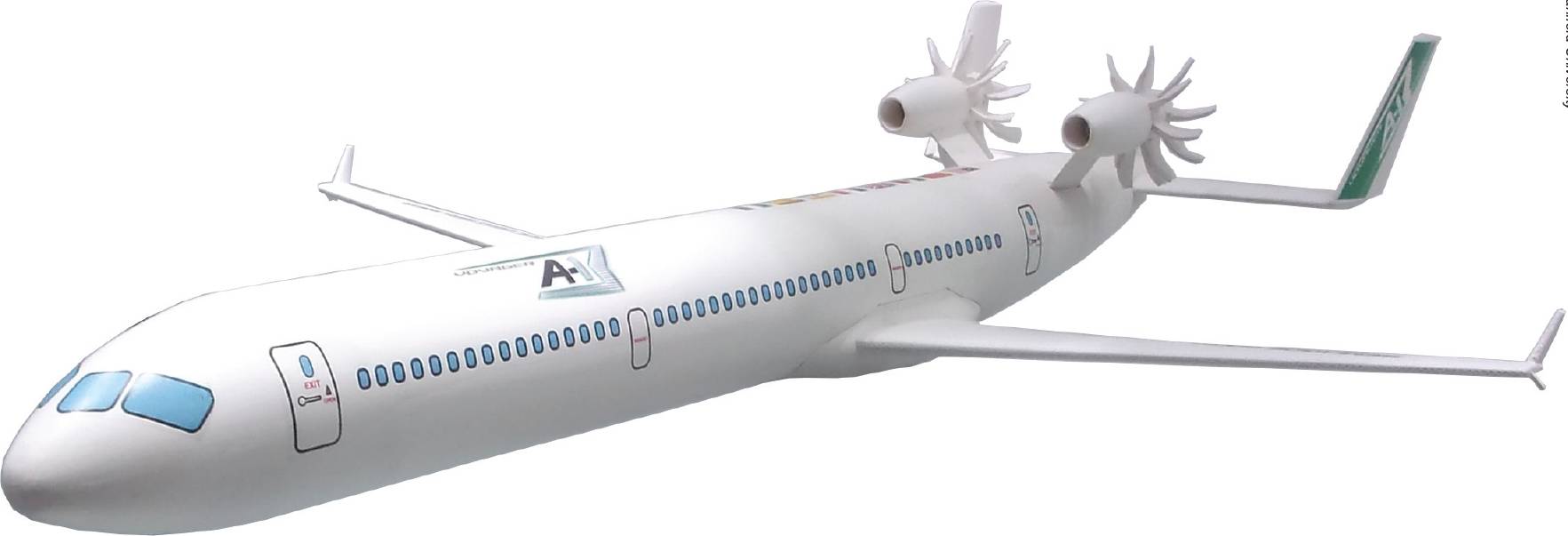 Green airliner of the future? A concept image of a model of the A-13 Voyager semi-widebody airliner powered by external open rotors created by students at Cranfield University in 2012/13. Cranfield University
Green airliner of the future? A concept image of a model of the A-13 Voyager semi-widebody airliner powered by external open rotors created by students at Cranfield University in 2012/13. Cranfield University
The hydrogen alternative
The speakers also discussed the potential of aircraft powered by liquid hydrogen stored in cryogenic fuel cells aboard the aircraft. “Hydrogen is a challenge,” admitted Jean Brice-Dumont. “Liquid hydrogen has the advantage that it produces no CO2 2 and NOx x but it has to be very cold and takes up more space than kerosene.”
One topic of discussion was how hydrogen fuel cells could be fitted aboard an aircraft. “The problem with fuel cells is how to store them,” stated Mike Stewart. Francis Preli asked the question as to whether the fuel cells needed to be aboard the aircraft at all and could they be put to better use located on the ground as a zero-emissions way to generate electricity for aircraft batteries.
The bigger picture
Although the emphasis of the conference was on technology, the speakers agreed that electrification and fuel were only part of the larger equation. “The goal is CO2 2 reduction,” said Mike Stewart. “Electric-powered aircraft have a role but we have to look at all options. You also need to consider fuel as part of the full system.”
Francis Preli highlighted that ICAO’s CO2 2 reduction roadmap includes a ‘basket of measures’ approach to reduce greenhouse gas emissions from aviation, including not just aircraft engine technology and biofuels but also operations and infrastructure. “Aircraft use a lot of fuel in flight holding patterns which could be saved by plotting better trajectories,” agreed Dumont. The presenters also noted that the introduction of electric-powered aircraft would require major changes to airport infrastructure. “Using drop-in fuels won’t require infrastructure changes but otherwise, every airport will need new infrastructure for particular aircraft,” said Paul Stein. “Anything we do must involve airports,” added Jean Brice-Dumont. “Introducing electric aircraft would involve new interfaces between airport and aircraft and ground handling systems.”
There are also wider implications for the services and support market, such as what will be the effect on the aerospace aftermarket of introducing electric-powered aircraft. Here, speakers did not envisage an immediate effect. “Electric aircraft will need less maintenance but their introduction won’t happen in the near future,” said Benoit Guyon. “Electric aircraft will change the aftermarket but not immediately,” assented Mike Stewart.
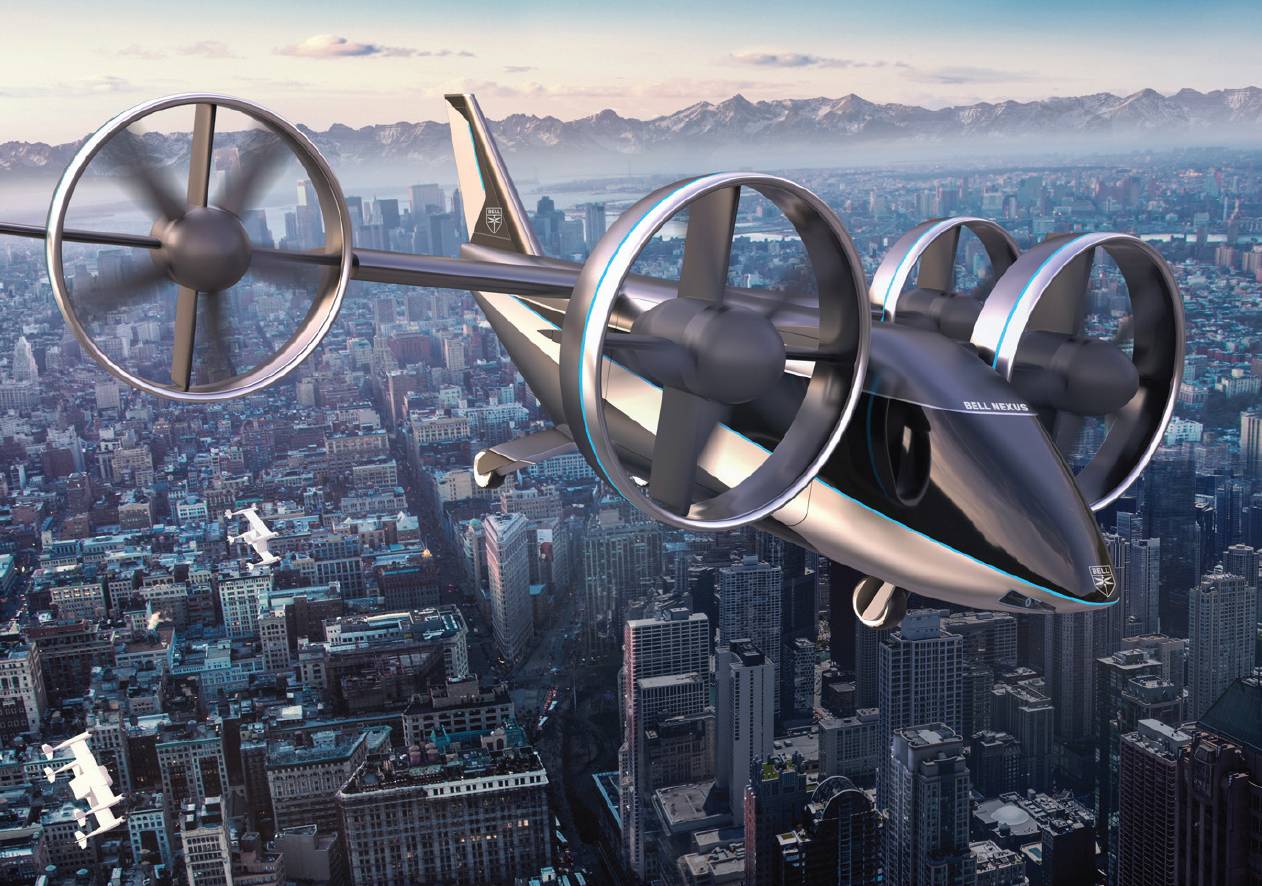 The Bell Nexus 4EX air taxi is planned to be capable of flying four to five passengers plus a pilot for distances up to 100km (62m) at a cruise speed of 241km/h (150mph). Bell Nexus
The Bell Nexus 4EX air taxi is planned to be capable of flying four to five passengers plus a pilot for distances up to 100km (62m) at a cruise speed of 241km/h (150mph). Bell Nexus
Visions of the future
Looking to the future, Benoit Guyon outlined a possible time frame as to how the aviation industry might transition from its present reliance on fossil fuels to carbon-free alternatives in the future. Starting from the current market in 2020 which relies on 100% jet fuel propulsion for long-haul, regional and helicopter transport, changes brought about by public policies, regulations and technology could start to change the industry. By 2030-35, he predicted the introduction of small electric short-range mobility solutions and hybrid-electric regional aircraft, together with new low-carbon, ultra-efficient conventional propulsion aircraft and the increased use of alternative fuels. By 2050, aviation could operate with zero emissions using future aircraft powered by carbon-free energy sources, such as green synthetic fuel, liquid hydrogen and ultra-high power density batteries.
Paul Stein predicted that eVTOLs powered by electric generators and batteries would begin to be used for personal and public transport, logistics, air ambulance, police and military by 2025. In 10 years’ time, 2030 would see the introduction of hybrid/distributed power aircraft designs for regional transport, including 20-seat hybrid short take-off and landing (STOL) design, 20-seat turbo-electric vertical take-off and landing (eVTOL) aircraft and 90-seat low noise hybrid-electric aircraft.
Working together
Finally, the conference speakers agreed that, for the aerospace industry to achieve its environmental goals, it will require all the players to work together. “Aviation is a global team sport,” said Paul Stein. “The goal for 2050 can be reached but needs to be a shared vision with industry, airlines, public authorities and energy experts,” added Benoit Guyon.
“We need collaborative innovation with aviation stakeholders,” commented Jean Brice-Dumont. “We are an industry of progress. We need to change course so that we connect people while being sustainable. However, I am very optimistic about the future because we are all working together.”
“Flying is not bad for the environment – CO2 2 is bad for the environment,” concluded Paul Stein. “Flight shaming is for history if aviation can move people about more efficiently.
Note: Because SATLF was held in February before the global spread of the Covid-19 virus, some of the research projects referred to may have subsequently been cancelled or curtailed but were active at the time of the event.
RAeS Climate Change Conference – 3/4 November 2020, RAeS HQ, London
A longer version of this article can be found on the AEROSPACE Insight blog
 The ACCEL is an electric aircraft demonstrator developed by Rolls-Royce. Rolls-Royce
The ACCEL is an electric aircraft demonstrator developed by Rolls-Royce. Rolls-Royce



